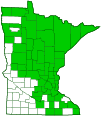horned clubtail
(Arigomphus cornutus)
Conservation • Description • Habitat • Ecology • Distribution • Taxonomy
|
|
||||||||||||||
Description |
Horned clubtail is an early season, medium-sized, 2 3 ⁄16″ long, pond clubtail. It is the most common pond clubtail (genus Arigomphus) in Minnesota. It is found throughout the state except in the southwest corner. The thorax is yellowish-green or greenish-yellow with black stripes: two shoulder stripes on each side, the upper stripe thick, the lower stripe thinner; and a thin top stripe on each side that wraps around and connects to the thinner shoulder stripe. The abdomen is slender and black with yellow markings. Unlike most clubtails, the abdomen has no club. The upper (dorsal) surface or abdominal segments 1 through 8 have yellow, elongated, triangular spots. Segment 9 is unmarked. Segment 10 is mostly yellow on top. All segments have a yellow lower margin. On segments 8 and 9, these are sometimes rusty red. On the male, segment 10 is wider than segment 9, a characteristic not seen on any other clubtail. At the tip of segment 10 the male has a pair of distinctive, widely forked claspers. The claspers are yellowish with black tips and resemble bulls horns in shape. Unlike other clubtails, the female has an ovipositor. It is spout-like and about ⅛ to ½ as long as the ninth abdominal segment. The head is small. The face is yellow. The large compound eyes are blue and do not meet at the top of the head. The area behind the compound eyes at the top of the head (occiput) on both sexes is high, convex, and plate-like. On the female it is yellow, very high, convex, and cleft in the middle. It is the most conspicuous occiput of any clubtail. The female also has a pair of tiny, black, horn-like protuberances between the compound eyes. This is the only pond clubtail (genus Arigomphus), but not the only clubtail (family Gomphidae), with these “horns”. It is the feature that gives this species its common name. The legs are black. The third and largest segment (femur) of the hind leg on the female is mostly yellow. The wings are clear except for a dark cell (stigma) on the leading edge near the tip. The vein on the leading edge of the forewing (costa) is yellow in front but may appear black from above or behind. The wing triangle, a section of intersecting veins about 20% of the way from the base to the wingtip, is about the same size in the forewing and the hindwing. |
Size |
Total length: 2 3 ⁄16″ |
Similar Species |
Habitat |
Small marshy lakes, muddy ponds, slow streams |
Ecology |
Season |
Late May to late July |
Behavior |
|
Life Cycle |
Breeding takes place in still waters. After mating the females deposits eggs by flying close to the water surface and tapping the tip of her abdomen into water. After the eggs hatch the young (naiads) live in submerged vegetation. When they mature they crawl onto a lily pad or partly out of the water on a vegetative stem to emerge as adults. |
Naiad Food |
|
Adult Food |
|
Distribution |
||
|
Sources Biodiversity occurrence data published by: Minnesota Biodiversity Atlas (accessed through the Minnesota Biodiversity Atlas Portal, bellatlas.umn.edu, 8/2/2025). Haarstad, J. 1997. The dragonflies of selected eastern Minnesota rivers. Report submitted to the Minnesota Department of Natural Resources. Unpaged. |
|
| 8/2/2025 | ||
Occurrence |
||
Fairly common, locally common |
||
Taxonomy |
|
Order |
Odonata (dragonflies and damselflies) |
Suborder |
|
Superfamily |
Gomphoidea |
Family |
Gomphidae (clubtails) |
Genus |
Arigomphus (pond clubtails) |
Superfamily Genus |
|
Subordinate Taxa |
|
|
|
Synonyms |
|
Gomphus cornutus |
|
Common Names |
|
horned clubtail |
|
Glossary
Costa
On plants: The central axis of a pinna, to which pinnules are attached. On insects: The vein on the leading edge of the forewing.
Femur
On insects and arachnids, the third, largest, most robust segment of the leg, coming immediately before the tibia. On humans, the thigh bone.
Naiad
The aquatic larval form (nymph) of a dragonfly, mayfly, or stonefly.
Occiput
The back of the head. In Odonata, Megaloptera, and Neuroptera, the upper part of the head behind the eyes.
Stigma
In plants, the portion of the female part of the flower that is receptive to pollen. In Lepidoptera, an area of specialized scent scales on the forewing of some skippers, hairstreaks, and moths. In other insects, a thickened, dark, or opaque cell on the leading edge of the wing.
Visitor Photos |
||
Share your photo of this insect. |
||
This button not working for you? |
||
Alfredo Colon |
||
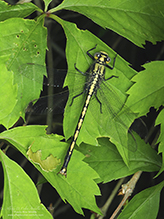 |
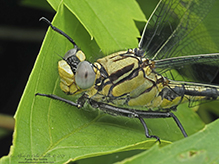 |
|
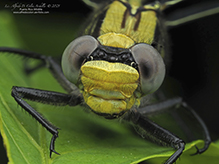 |
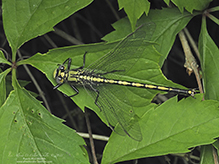 |
|
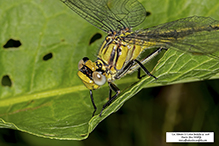 |
||
Dan W. Andree |
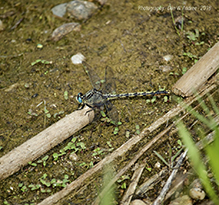 |
Horned Clubtail Dragonfly... Came across this interesting dragonfly at a pond in Norman County June 2018. Colorful eyes on this Horned Clubtail (Gomphidae) Dragonfly. |
MinnesotaSeasons.com Photos |
||
|
||
|
||

Slideshows |
Horned Clubtail |

|

Visitor Videos |
||
Share your video of this insect. |
||
This button not working for you? |
||
|
Other Videos |
||
Horned Clubtail feeding |
About
Published on Jun 14, 2016 A Horned Clubtail dragonfly feeding on a bee. |
Voila! |
About
Published on May 18, 2012 Horned Clubtail (Arigomphus cornutus) during emergence. May 18, 2012, at River Bend Nature Center in Faribault, Minnesota. |

Visitor Sightings |
||
Report a sighting of this insect. |
||
This button not working for you? |
||
| Alfredo Colon 5/30 to 6/1/2021 |
Location: Woodbury, MN |
| Alfredo Colon 7/31/2018 |
Location: Woodbury, MN |
 |
| Dan W. Andree June 2018 |
Location: Norman County Came across this interesting dragonfly at a pond in Norman County June 2018. Colorful eyes on this Horned Clubtail (Gomphidae) Dragonfly. |
 |
MinnesotaSeasons.com Sightings |
||
|

Created: 7/8/2018 Last Updated: © MinnesotaSeasons.com. All rights reserved. |
